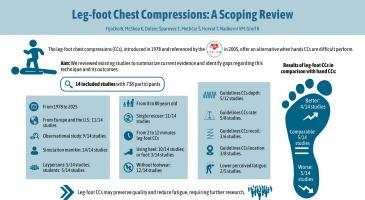下肢胸外按压:范围回顾
IF 2.4
Q3 CRITICAL CARE MEDICINE
引用次数: 0
摘要
目的高质量的胸外按压(CCs)对恢复自然循环至关重要。当用手抄送困难时,用脚抄送可能是另一种选择。我们回顾了现有的研究,以描述当前的证据,并确定文献中关于该技术及其对结果的影响的空白。方法在2024年11月至12月期间,我们进行了范围综述,检索了8个数据库、2个论文集(Resuscitation 2024和Resuscitation Science Symposium 2024)、一份试验登记、动物指南、引文和参考文献列表。我们纳入了由外行人、医疗保健专业人员、执照前学生或责任回应外行人对人类、动物或人体模型进行的腿脚CCs的研究。干预是腿脚CCs;比较的是标准手cc。结果是可行性、可接受性和有效性(率、深度、后坐力、位置)。符合条件的设计包括1960年至2024年的试验、非随机研究、病例报告和带英文摘要的研究信函。结果在1173项记录中,我们确定了14项比较腿脚和手cc的研究,所有研究都使用人体模型,主要来自西方国家(11/14项研究)。未发现人体研究。12个比较深度,9个比较速率,6个比较后坐力,8个比较位置。大多数研究没有发现明显的亚组差异,尽管一些研究报告说,体重较重的参与者或使用平衡辅助设备时表现更好。几项研究观察到总体上的速率、后坐力和位置的差异。在评估疲劳的五项研究中,有两项倾向于腿脚cc,一项是混合cc,还有两项倾向于手部cc。结论未发现人体下肢CCS的研究。在人体模型上,腿脚CCs是可行的,可能会减少疲劳,但结果各不相同。需要更多的研究,包括动物或人体研究。本文章由计算机程序翻译,如有差异,请以英文原文为准。

Leg-foot chest compressions: a scoping review
Objectives
High-quality chest compressions (CCs) are vital for the return of spontaneous circulation. When hand CCs are difficult, leg-foot CCs may offer an alternative. We reviewed existing studies to describe the current evidence and identify gaps in the literature regarding this technique and its impact on outcomes.
Methods
Between November and December 2024, we conducted a scoping review, searching eight databases, two proceedings (Resuscitation 2024 and the Resuscitation Science Symposium 2024), a trial register, animal guidelines, citations, and reference lists. We included studies on leg-foot CCs performed on humans, animals, or manikins by laypersons, healthcare professionals, pre-licensure students, or duty-to-respond laypersons. The intervention was leg-foot CCs; the comparison was standard hand CCs. Outcomes were feasibility, acceptability, and effectiveness (rate, depth, recoil, location). Eligible designs included trials, non-randomised studies, case reports, and research letters with English abstracts from 1960 to 2024.
Results
Out of 1173 records, we identified 14 studies comparing leg-foot and hand CCs, all using manikins, mostly from Western countries (11/14 studies). No human studies were identified. Twelve compared depth, nine rate, six recoil, and eight location. Most studies found no significant subgroup differences, though some reported better performance in heavier participants or when using a balance aid. Several studies observed differences in rate, recoil, and location overall. Of five studies assessing fatigue, two favoured leg-foot CCs, one was mixed, and two favoured hand CCs.
Conclusion
No human studies of leg-foot CCS were identified. On manikins, leg-foot CCs are feasible and may reduce fatigue, but results vary. More research, including animal or human studies, is needed.
求助全文
通过发布文献求助,成功后即可免费获取论文全文。
去求助
来源期刊

Resuscitation plus
Critical Care and Intensive Care Medicine, Emergency Medicine
CiteScore
3.00
自引率
0.00%
发文量
0
审稿时长
52 days
 求助内容:
求助内容: 应助结果提醒方式:
应助结果提醒方式:


